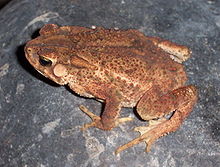Ingerophrynus
| Ingerophrynus | |
|---|---|

| |
| Crested toad (Ingerophrynus biporcatus) | |
| Scientific classification | |
| Kingdom: | Animalia |
| Phylum: | Chordata |
| Class: | Amphibia |
| Order: | Anura |
| Family: | Bufonidae |
| Genus: | Ingerophrynus Frost et al., 2006[1] |
| Species | |
|
12 species (see text) | |
Ingerophrynus is a genus of true toads with 12 species.[2][3] The genus is found in southern Yunnan and Southeast Asia; from Myanmar and Indochina to peninsular Thailand and Malaya, Sumatra, Borneo, Java, Nias Island, Sulawesi, and the Philippines.[2] This genus was established after a major taxonomical revision of frogs in 2006.[1]
Taxonomy and systematics[]
Ten of the species in this genus were formerly considered species of the genus Bufo, most of them in what had been known as the Bufo biporcatus group; the remaining ones were assigned to this genus based on molecular data.[1] In 2007 a new species, Ingerophrynus gollum, was added to this genus.[4] The sister taxon of Ingerophrynus is Sabahphrynus.[2]
Etymology[]
The generic name Ingerophrynus honors Robert F. Inger, an American zoologist from the Field Museum of Natural History.[1][5]
Description[]
The diagnostic characters of the Bufo biporcatus group are the presence of supraorbital, parietal, and supratympanic crests, lack of a tarsal ridge, presence of vocal sacs but absence of melanophores in the surrounding muscle tissue, lack of tibial glands, lack supinator manus humeralis and adductor longus muscles, presence of paired crests on the vertebral column, rugose skull, squamosal bones with broad dorsal otic plates, and smooth palatine bones.[4]
Species[]
| Binomial Name and Author | Common Name |
|---|---|
| Ingerophrynus biporcatus (Gravenhorst, 1829) | Crested toad |
| Ingerophrynus celebensis (Günther, 1859) | Sulawesian toad |
| Ingerophrynus claviger (Peters, 1863) | Benkulen toad |
| Ingerophrynus divergens (Peters, 1871) | Malayan dwarf toad |
| Ingerophrynus galeatus (Günther, 1864) | Bony-headed toad |
| Ingerophrynus gollum Grismer, 2007 | |
| Ingerophrynus kumquat (Das and Lim, 2001) | |
| (Fei, Ye, and Huang, 2009) | |
| Ingerophrynus macrotis (Boulenger, 1887) | Big-eared toad |
| Ingerophrynus parvus (Boulenger, 1887) | Lesser Malacca toad |
| Ingerophrynus philippinicus (Boulenger, 1887) | Philippine toad |
| Ingerophrynus quadriporcatus (Boulenger, 1887) | Greater Malacca toad |
References[]
- ^ a b c d Frost, D. R.; Grant, T.; Faivovich, J. N.; Bain, R. H.; Haas, A.; Haddad, C. L. F. B.; De Sá, R. O.; Channing, A.; Wilkinson, M.; Donnellan, S. C.; Raxworthy, C. J.; Campbell, J. A.; Blotto, B. L.; Moler, P.; Drewes, R. C.; Nussbaum, R. A.; Lynch, J. D.; Green, D. M. & Wheeler, W. C. (2006). "The amphibian tree of life". Bulletin of the American Museum of Natural History. 297: 1–291. doi:10.1206/0003-0090(2006)297[0001:TATOL]2.0.CO;2. hdl:2246/5781.
- ^ a b c d Frost, Darrel R. (2018). "Ingerophrynus Frost, Grant, Faivovich, Bain, Haas, Haddad, de Sá, Channing, Wilkinson, Donnellan, Raxworthy, Campbell, Blotto, Moler, Drewes, Nussbaum, Lynch, Green, and Wheeler, 2006". Amphibian Species of the World: an Online Reference. Version 6.0. American Museum of Natural History. Retrieved 7 March 2018.
- ^ a b "Bufonidae". AmphibiaWeb. University of California, Berkeley. 2018. Retrieved 7 March 2018.
- ^ a b Grismer, L. Lee (2007). "A new species of Ingerophrynus (Anura: Bufonidae) from a lowland rain forest in southern peninsular Malaysia". Journal of Herpetology. 41 (2): 225–230. doi:10.1670/0022-1511(2007)41[225:ansoia]2.0.co;2. JSTOR 4498578.
- ^ Beolens, Bo; Watkins, Michael & Grayson, Michael (2013). The Eponym Dictionary of Amphibians. Pelagic Publishing. pp. 101–102. ISBN 978-1-907807-42-8.
- Bufonidae
- Ingerophrynus
- Amphibian genera
- Amphibians of Asia
- Taxa named by Jonathan A. Campbell
- Taxa named by Darrel Frost
- Taxa named by Taran Grant
- Taxa named by John Douglas Lynch
- Taxa named by Ronald Archie Nussbaum
- Taxa named by Christopher John Raxworthy